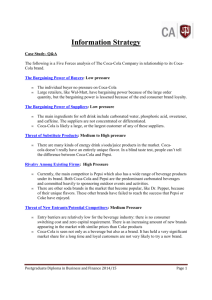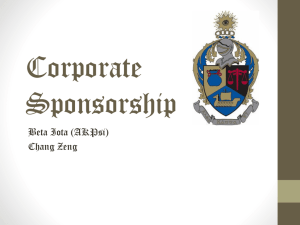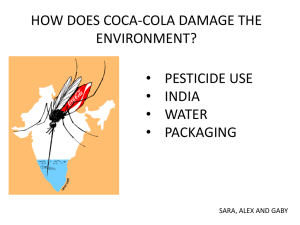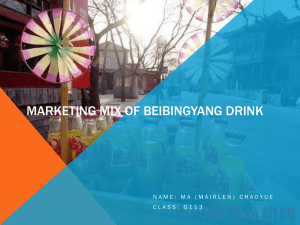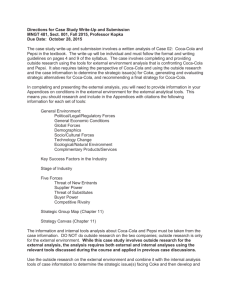File - Ryan Nusbaum's eportfolio
advertisement
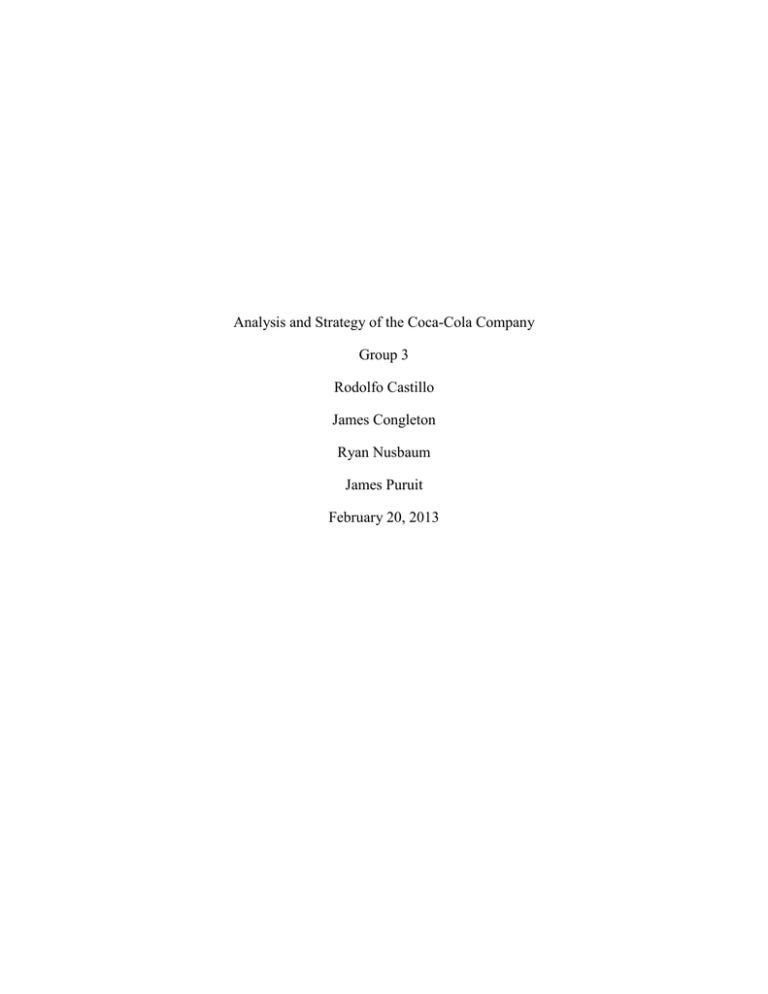
Analysis and Strategy of the Coca-Cola Company Group 3 Rodolfo Castillo James Congleton Ryan Nusbaum James Puruit February 20, 2013 Group 3 Paper The Coca-Cola Company is known for their brand and the excellence they have achieved to become the leader in the beverage industry. To understand how they have achieved their superiority, one must understand their history and how they compare to other beverage companies. History John Pemberton who created what is now the Coke-Cola brand. It all begun in 1886 in Atlanta, Georgia when he created a concoction of colored liquid and carbonated water which was created at Jacob’s Pharmacy. The drink was well received by samplers so then he sold it to the regular customers at the pharmacy for 5 cents a glass. In Coca-Cola’s first year of existence they only sold 9 glasses of coke daily. Frank Robinson, Pemberton’s bookkeeper, was the one to come up with the name Coca-Cola and wrote it out in his distinct handwriting which is still written to this day. After Pemberton’s death the business was bought by Asa Candler for $2,300. He was the first president in Coca-Cola’s history. In 1893, Coca-Cola began to heavily promote their product. Candler began to distribute coupons for complimentary tastes of the new drink to consumers and also distributed clocks, urns, and calendars bearing the Coca-Cola brand to many pharmacists. Customers began to recognize the brand more and more as time passed. Coca-Cola began to bottle their product in 1894 thanks to Joseph Biedenharn. This became a famous phenomenon at the time because Coca-Cola was now portable to people. In the 1920’s the Woodruff dynasty began at the Coca-Cola Company. Ernest Woodruff bought the company from Asa Chandler in 1919 who would present the Coca-Cola beverage to the world. Ernest Woodruff appointed his son, Robert Woodruff, president of the company years later. He introduced the brand overseas for the first time at the Amsterdam Olympics in 1928. 2 Group 3 Paper This experienced showed that customers worldwide had a variety of taste preferences. Coca-Cola decided to broaden their scope with new flavors such as: Fanta, Sprite, TAB and Fresca. The Coca-Cola Company also acquired The Minute Maid Company, which added a new line juices to the company. Roberto Goizueta, a Cuban immigrant, became the CEO of the Coca-Cola Company in 1981. He implemented a new strategy once he got there called “intelligent risk taking”, which is taking risks in a smart and efficient way. As CEO he accomplish in turning the company’s bottling operations into a public company, Coca-Cola Enterprises Inc. Goizueta also introduced the first extension of the Coke trademark; Diet Coke ®. The next two years the drink had jumped up as the top low-calorie drink in the world. Goizueta most notable achievement was the change in taste for Coca-Cola. Taste tests proved that people loved the new Coke but everyone had an intense attachment to the original flavor. To this day, Coca-Cola is now enjoyed in more than 200 countries around the world and is written in over 80 languages. (Coca-Cola Incorporated, 2013) Industry Analysis Using Porter’s five forces model, a complete analysis of Coca-colas competitors can be made. Porter’s 5 forces must be applied to the beverage industry to see the results. In order to analyze this more, we need to split it up into two groups, the forces related to the competition and the forces related to the supply chain’s bargaining power. Remember that the industry that the Coca-Cola Company competes in is the beverage industry. Listed below is a complete analysis of each industry force for the Coca-Cola Company. 3 Group 3 Paper The threat of substitute products to the Coca-Cola Company is high pressure. In a blind taste test, Coca-Cola could not be differentiated between Pepsi cola, RC cola or Vess Cola. (Breneiser, 2011) This poses a threat because some customers would not be able to tell the difference once they drink another company’s product. Since there are many soda products in the market there are many other alternatives the customer can buy. The threat of new entrants or potential competitors to the Coca-Cola Company is median pressure. The entry barriers for entering the soft drink industry are relatively low. Customers are not bound to any switching cost and the capital required is relatively low. It is easy for a company with a cost strategy to enter because they will offer a lower price than Coke products. An example of new entries could be a store brand soft drink brand. Even though a company can enter the industry, Coca-Cola will still own a large amount in the market share due to their loyal customer base. The rivalry among existing firms to the Coca-Cola Company is high pressure. CocaCola’s main competitor, Pepsi Co., has wide variety of beverage products which try to induce the attention of customers. They try to attract customers to by sponsoring festivals and sporting events. When it comes to marketing, Coca-Cola tends to advertise a more classical approach while Pepsi tried to attract younger generation. Coca-Cola does not want to give up their status as the possessor of the U.S. market share and will compete to their fullest potential. The bargaining power of buyers to the Coca-Cola Company is low pressure. The individual buyer has no pressure on the Coca-Cola Company because of their relative size. When it comes to the power individual retailers have, they will be able to negotiate a deal with Coca- 4 Group 3 Paper Cola due to their size but do not have absolute power because of their brand loyalty to Coca-Cola customers have. The bargaining power of suppliers to the Coca-Cola Company is low pressure. To analyze the bargaining power of suppliers one must see ingredients needed to create Coca-Cola such as carbonated water, phosphoric acid, sweetener, and caffeine. The suppliers for these ingredients are not concentrated so they can always be replaced. There are plenty of substitutes available if needed. If a supplier would want to leave the Coca-Cola Company that would be a foolish decision considering the size the company holds. (Valuation Academy, 2013) Competitive Strategy Coca-Cola can be addressed as a company with an industry wide-differentiation strategy. Coca-Cola offers a variety of drinks across the beverage industry. Not only does it offer soft drinks but it also sells toward the sports drink industry, energy drink industry and water industry. Coca-Cola has worked toward this strategy by being consistent in its taste and giving their customers what they want. The Coca-Cola Company’s biggest competition in the beverage market is Pepsi Co. Both companies put out a variety of similar products and sell their products at nearly the same price. At this moment, more people prefer Coca-Cola over Pepsi. This is why they are considered the better brand across the beverage industry. Research has shown that when people are put in a blind taste test that they could not actually decide which was Pepsi or Coke. But when given the drinks with the labels on them most people chose Coke (Breneiser, 2011). This is because Coke has implemented a great differentiation strategy through which it is perceived as a superior quality product. The way the company brands their image with promotions and packaging of the 5 Group 3 Paper liquid into the classic “Coke Bottle," are also ways of differentiation (Coca-Cola Incorporated, 2013). Given that Coca-Cola is one of the most established brands around the world they don't really have a need to worry if their product is slightly more expensive in order to gain an advantage. You can generally find a Coca-Cola product in some of the most remote places of the world. This brand recognition makes it extremely difficult for competitors because they aren't as well known and people are hesitant to switch from their norms. 6 Group 3 Paper Works Cited Breneiser, Jennifer E., and Sarah N. Allen. "Taste Preference for Brand Name versus Store Brand Sodas." North American Journal of Psychology 1 June 2011: n. pag. Print. Coca-Cola Incorporated. "Coca-Cola History: Coca-Cola Heritage Timeline." Coca-Cola History: Coca-Cola Heritage Timeline. Coca-Cola Incorporated, 2006. Web. 19 Feb. 2013. Valuation Academy. "Porter™s Five Forces In Action: Sample Analysis of Coca-Cola." Valuation Academy RSS. Valuation Academy, 2013. Web. 20 Feb. 2013. 7

